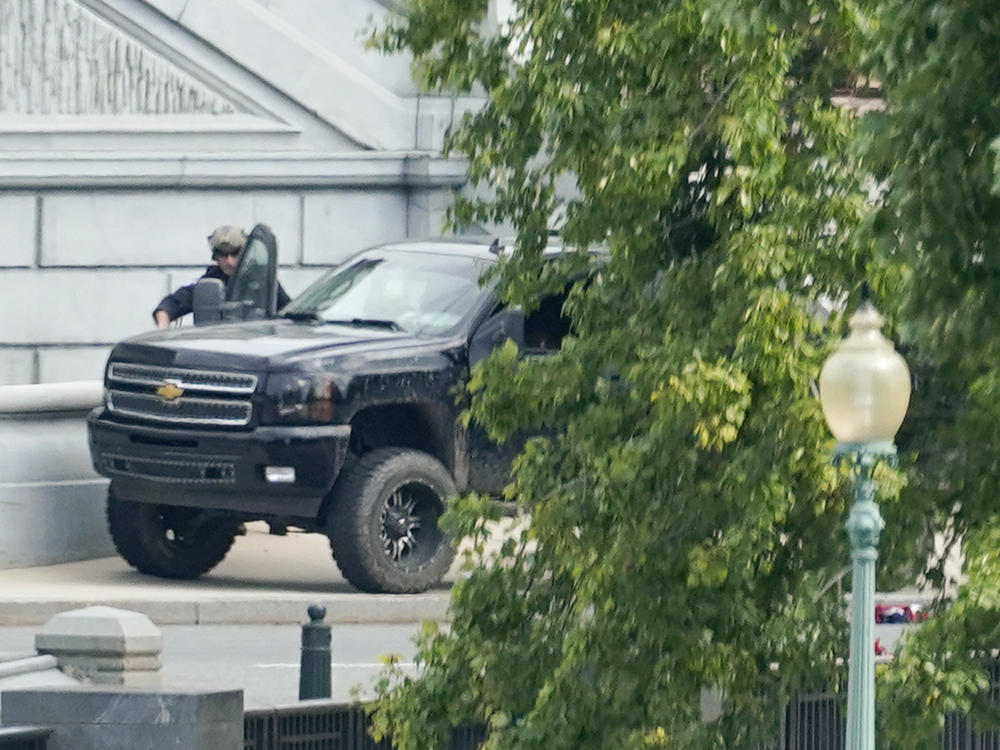Section Branding
Header Content
Questions About Security Around The Capitol Complex Emerge After Bomb Threat
Primary Content
The confrontation between authorities and a man who pulled up next to the Library of Congress claiming to have a bomb in his truck ended with his surrender on Thursday afternoon.
It took hours of negotiations and at least three law enforcement agencies — the U.S. Capitol Police, the FBI and the Bureau of Alcohol, Tobacco, Firearms and Explosives — to persuade Floyd Ray Roseberry to stop ranting about a "revolution" and to turn himself over to authorities.
But the ease with which Roseberry gained such close access to the sidewalk next to the Library of Congress' Thomas Jefferson building, which is itself very near the U.S. Capitol and the Supreme Court, raises new questions about the security of nation's most important symbols of democracy just seven months after the rioting and deadly violence of the Jan. 6 insurrection.
More attacks are probably inevitable
Malcolm Nance, a former Naval intelligence and counterterrorism officer, says Roseberry would never have gotten close to the Capitol complex had authorities moved to erect a permanent fence around the perimeter, as it has been debating for years.
"It should have happened long ago," Nance tells NPR. He says it shouldn't be a question of if a permanent barrier should be built, but when.
There was a protective fence built around the Capitol after the siege, but it was taken down last month. An outer perimeter fence was removed in March. Capitol Police explained that it would monitor intelligence for any threats to the complex and that the temporary fence could be reinstalled if needed.
Nance disagrees with that approach. Based on his ongoing monitoring of far-right radicalized groups throughout the country, he believes more bomb threats and other violence targeting symbolic institutions are inevitable.
There is a looming "insurgency where this is going to happen a lot only, there's a lot of potential for it not to be threats," he says.
He maintains that the only way to effectively protect lawmakers and civil servants in and around the Capitol complex is to use the same type of defensive military tactics the U.S. applies in fighting terrorism around the world.
"We don't need a bomb blast to damage the Supreme Court, the Library of Congress and the U.S. Capitol building," he says, adding that an appropriate "blast radius is about 680 yards."
Congress approved a $2.1 billion package to boost security
Late last month, Congress approved a $2.1 billion package to improve member security and harden the Capitol's security.
Roughly $950 million of that will be directed toward installing new security measures for members of Congress and fortifying the Capitol. That could include the construction of a retractable or mobile fencing system, hardening of doors and windows, the installation of new security screening vestibules and cameras.
It also allocates about $3.3 million for the Capitol Police intelligence division and $5 million for equipment, and another $18 million to provide body cameras to officers, specialized training, and new physical barriers.
Adding barriers would "rip the heart out of the city"
Daniel Schuman is policy director of Demand Progress, where he monitors the Capitol Police for the advocacy organization. He said further militarizing what should be public spaces and boosting staffing are the wrong solutions for addressing the growing domestic terrorism problem.
Schuman notes Capitol Police has a budget of a half-billion dollars, but it has no obligation to disclose how it spends that money or uses existing equipment.
"What Jan. 6 demonstrated was that a lot of these things aren't being deployed very well," he told NPR.
He opposes any plan that may include a 10-foot-high fence. "It would rip the heart out of the city."
"It's a terrible symbol," he adds.
But a more substantive downside is the divide it creates between citizens and their representatives.
"Every time you add an additional layer between people and the people that represent them, you create further distance. It becomes harder for members of Congress and their staff to hear from folks that the laws affect."
Schuman notes that Roseberry, a pro-Trump supporter who was livestreaming himself on Facebook while threatening to detonate a bomb outside of the Library of Congress, called himself a "patriot" and demanded that Democrats step down.
"In this crisis of democratic legitimacy," Schuman said, "we don't want to take the most democratic institution and make it even harder to interact with."
Copyright 2021 NPR. To see more, visit https://www.npr.org.

